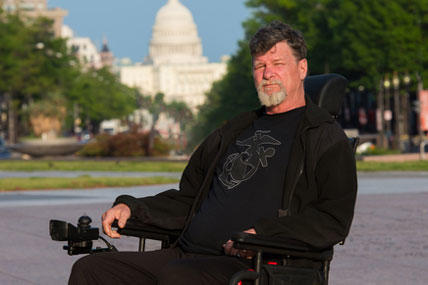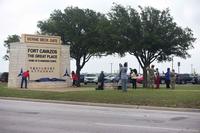Those stricken by Lou Gehrig's disease and their families gathered in Washington Wednesday to lobby Congress for more funding to research a cure for the terminal ailment that hits veterans hard.
"I'm two times more likely as a veteran to get the disease," said Ed Tesarro, a former Army lieutenant who was stationed at Fort Bliss, Tex., from 1968-70 and who was diagnosed with amyotrophic lateral sclerosis (ALS) six years ago.
"It's still a big conundrum" as to why vets would be more prone to the degenerative disease named for the Hall of Fame Yankee first baseman who died of ALS in 1941 at age 37, Tesarro said.
Tesaro and about 30 other stricken vets in motorized wheelchairs attended the first day of the annual three-day conference of the ALS Association, a non-profit with the mission of raising money for research and providing assistance to ALS patients and their families.
On Thursday, the vets, their families and ALSA members went to Capitol Hill to promote ALS awareness and lobby for more research funding from lawmakers.
At the opening of the conference, ALSA President Jane Gilbert noted that July 4 will be the 75th anniversary of Lou Gehrig's dramatic farewell at Yankee Stadium in 1939 when he called himself "the luckiest man on the face of the Earth" despite having ALS that would soon take his life.
"Seventy-five years is a long time and it's amazing we have not had more advances" in finding new methods of treatment and a cure, Gilbert said.
Other notables who have died of the progressive neuro-degenerative effects of ALS are Army Gen. Maxwell Taylor, Hall of Fame pitcher Jim "Catfish" Hunter, the actor David Niven , and former Vice President Henry A. Wallace.
An estimated 30,000 Americans have ALS and an ALSA report last year on "ALS In The Military" stated that vets "are at greater risk of dying from ALS than if they had not served in the military."
Harvard University studies funded by the Defense Department and the National Institutes of Health concluded in 2005 and again in 2009 that military veterans were twice as likely as the general population to develop ALS.
Based on the Harvard studies and other research, the Department of Veterans Affairs published regulations establishing a service connection for ALS, making vets with ALS and their survivors eligible for benefits.
The VA had earlier set up a registry to identify cases of ALS in military veterans. From 2003-2007, the registry identified more than 2,100 cases of ALS among veterans.
Gilbert said that ALS research has received about $850 million in government funding over the last 10 years, with the Defense Department taking a support role through its own ALS Research Program.
DoD allocated $6.4 million for ALS research in 2012, $7.5 million in 2013, and $7.5 million in 2014, said Patrick Wildman, director of Public Policy for ALSA. Still, the causes of ALS and effective therapies for the eventual total paralysis from the disease are unknown, Wildman said.
ALS was first discovered in 1869 by the French neurologist Jean-Martin Charcot but only one drug – Rilutek – has been approved by the Food and Drug Administration for treatment of ALS, Wildman said.
Rilutek has been shown to prolong the lives of ALS victims by about three months, Wildman said.
"This has been such a challenging disease," Dr. Nicholas Maragakas, a Johns Hopkins neurologist, told the conference. "Progress has been made but there are no answers," he said.
Maragakas described his research with stem cells and his efforts at gaining federal approval for clinical trials with ALS victims.
"People are always surprised that service members are more prone to this," said Richard Thiede, 50, a retired Marine sergeant from Atlanta who was diagnosed with ALS in 2010.
"Myself, I don't believe its chemical or exposure to this or that that's causing it," he said. "We just need to do a lot more" on funding research.
-- Richard Sisk can be reached at richard.sisk@monster.com




























